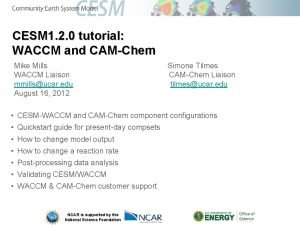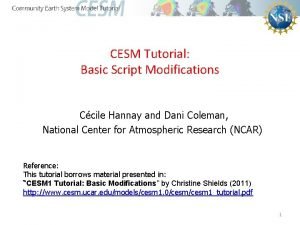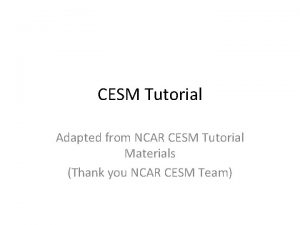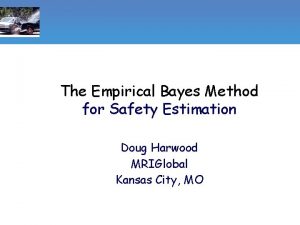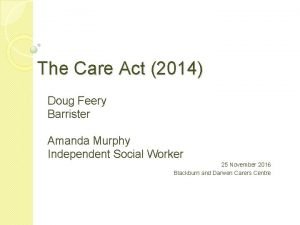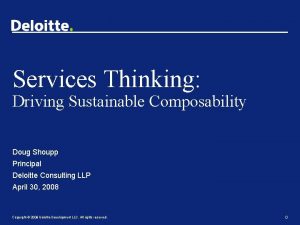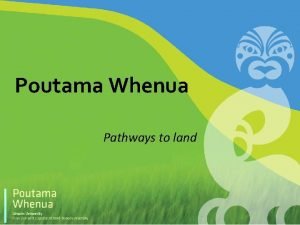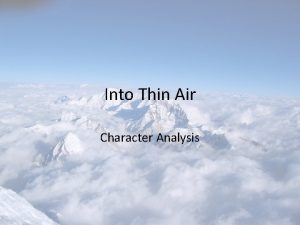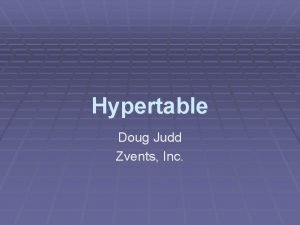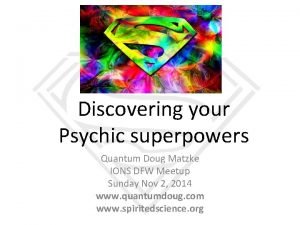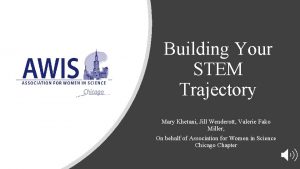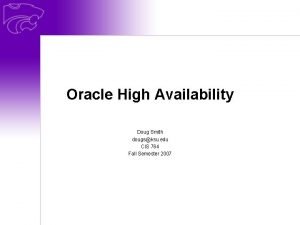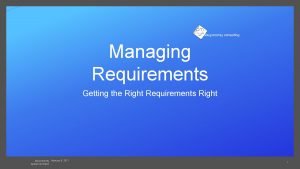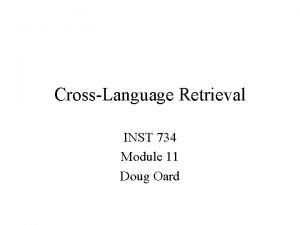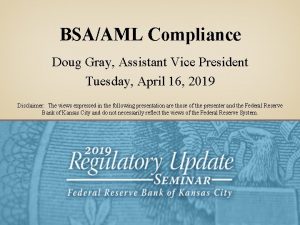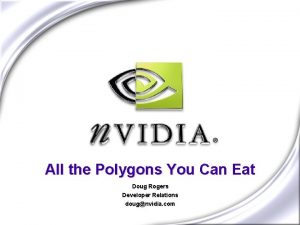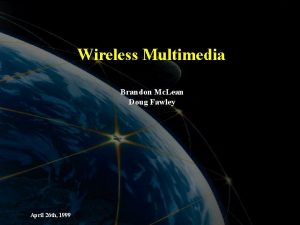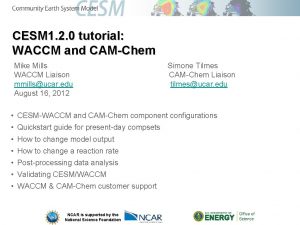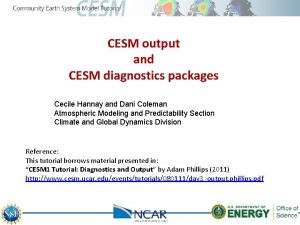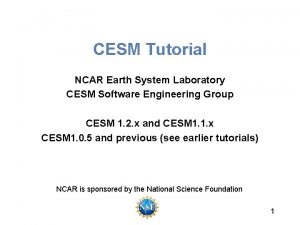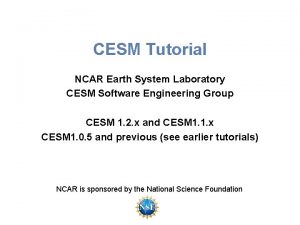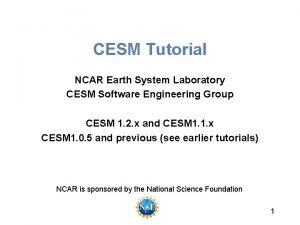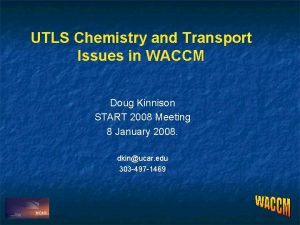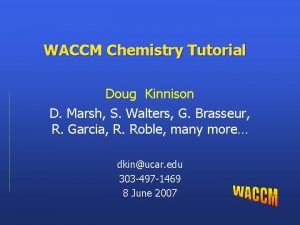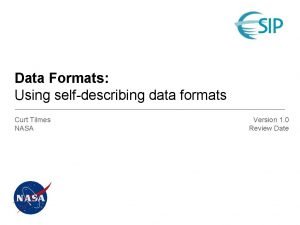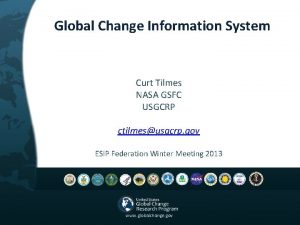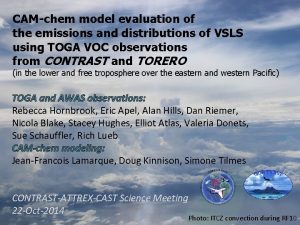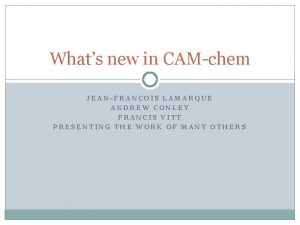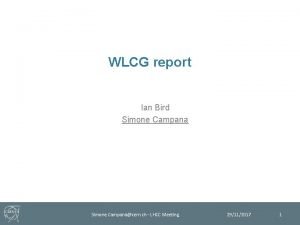CESM 2 WACCM CAMchem Simone Tilmes and Doug






















- Slides: 22

CESM 2 WACCM / CAM-chem Simone Tilmes and Doug Kinnison and the CAM-chem and WACCM team Monday July 30 th, 2018

CESM 2 model components Atmospheric Models • CAM-chem • WACCM Model can be run in very different configurations • Coupled /prescribed ocean and ice • Coupled or prescribed land • Free running or nudged to meteorological fields

Overview of the atmospheric components of CESM WACCM/CAM/chemistry modeling suite WACCM/ CAM-chem levels WACCM X WACCM top CAM top Stratosphere • • Unified vertical grid below about 50 h. Pa Circulation / Transport representation depends on resolution and model top

WACCM/CAM-chem unified chemistry

Chemistry-Climate Interactions in CESM 2

WACCM/CAM-chem configurations Standard (CMIP 6) Configuration WACCM / CAMchem • 1 horizontal resolution, interactive QBO (gravity waves) • Comprehensive chemistry throughout the atmosphere • Aerosol with Modal Aerosol Model; VBS SOA scheme • Prescribed greenhouse gas concentrations, including CO 2, CH 4, N 2 O, CFCs etc. • Interactive biogenic emissions, interactive volcanic emissions • Prescribed / interactive fire / biogenic emissions Extended Configuration • Extended VBS scheme including emission sources • CO tagging and some NOx tagging • Extended very-short-lived halogens, including iodine • Potential to run with extended ion chemistry (MAD)

CAM-chem configurations

The chemical preprocessor and the mechanism file • The chemistry preprocessor: generates CAM Fortran source code to solve chemistry. • Input: a simple ASCII file listing chemical reactions and rates. • Input files for default chemical mechanisms are in each source code subdirectory for mechanisms under $CCSMROOT/models/atm/cam/src/ch emistry/pp_* (i. e. pp_waccm_mozart)

Modal Aerosol Model (MAM) MAM is coupled to the cloud micro-physics • aerosols are radiatively active • direct and indirect effect is including Curtesy Mike Mills Liu et al. , 2016 MAM 4 -> represent aging of BC

Prognostic Volcanoes New SO 2 database • Includes amount and altitude of SO 2 injections from eruptive volcanoes OCS chemistry • Contributes to stratospheric sulfate Thanks to Mike. Mills Results agree very well with observations Interactive with chemistry, radiation and dynamics • Includes interactive H 2 SO 4 and SO 4 formation • Requires comprehensive stratospheric chemistry

New SOA approach in CESM 2 CAM-chem, WACCM • More physical approach • Direct coupling to biogenic emission changes from MEGAN -> couples SOA formation to land use and climate change -> VBS (volatility bin scheme) only works in full chemistry version at this point Hodzic et al. , 2016

Stratospheric Chemistry / Heterogenous Reactions Halogen SRC Gases: CFC-11, -12, -113, -114, -115; CCl 4, CH 3 CCl 3; HCFC-22, -141 b, -142 b; halon 1211, -1301, -2402, -1202, CHBr 3, CH 2 Br 2. Gas-phase rxns: Included in the Ox, HOx, NOx, Cl. Ox, and Br. Ox families (part of TS 1 MLT). 231 species, 150 photochemical reactions, 416 thermal. Heterogeneous rxns: 17 reactions on three aerosol types (NAT, STS, and Water-Ice) Other Processes: ion-neutral reactions and chemical potential heating.

Photolysis Approach (combination of inline and LUT) J (p) = Fexo ( ) x Nflux(p, ) <= EUV (LUT) Inline (33 Bins) x ( ) LUT (67 Bins) 750 nm 200 nm 121 nm Fexo: Lean ( ) dependent extraterrestrial flux. Modified by the Earth-Sun distance (esfact). Inline Calculation: • JO 2 Lyman Alpha Nflux (normalized actinic flux) is based on TUV (Madronich), 4 -stream radiative transfer. • JO 2 SRB • JNO SRB • x for all other J’s • Nflux (p, ) is funct. of (O 3, O 2) LUT: Nflux (p, ) is function of (pressure, col. O 3, SZA, Albedo) LUT: ( ) x ( ) is function of ( T, p ) CAM 4 SW Heating rates Heating and Photolysis rates Cloud correction factor is applied to total J (Madronich).

Tropospheric Column Ozone Difference to OMI/MLS CCMI Comparison (Revell et al. , 2018)


Backups

Secondary Organic Aerosol Description Simplified Chemistry: • SOAG derived from fixed mass yields • no interactions with land SOAG species OH Anthropogenic Source / Fires Modified after C. Heald, MIT Cambridge Comprehensive Chemistry: • SOAG formation derived from VOCs using VBS scheme • 5 volatility bins • Interactive with land emissions -> more physical approach

44 Tg/yr wet dry 108 Tg/yr Net gas-particle partitioning Depends on J values for different chemicals SOA 1. 04 Tg 142 Tg/yr J SOA Oxygenated VOC (gas) 0. 38 Tg Lifetime: 4. 5 years wet Biogenic, anthropogenic and biomass burning VOC, SIVOC Oxidants chem. Prod. +Glyoxal uptake 294 Tg/yr VBS Budgets 1995 -2010 dry Most of it from biogenic emissions -> strongly dependent on MEGAN emissions 12 Tg/yr Values very close to observational estimates! 57 Tg/yr 72 Tg/yr

January April Stratospheric Ozone Column (DU) Observations (OMI/MLS) WACCM 1 (CCMI) WACCM CAM-chem July October Additional GW tuning for CAM-chem may be needed

Total Column Ozone 63 -90 o. S October Observations WACCM 1 WACCM CAM-chem From Doug Kinnison

Tropospheric Ozone Western Europe Eastern U. S. 900 h. Pa 500 h. Pa Ozonesondes WACCM CAM-Chem 900 h. Pa 500 h. Pa Observations WACCM CAM-Chem Very good agreement in summer, high bias in winter northern latitudes

January July April Tropospheric CO Observations (MOPITT) WACCM 1 WACCM CAM-chem October CO is reduced compared to WACCM 1 -> new CO emissions are lower
 Cesm compsets
Cesm compsets Cesm tutorial
Cesm tutorial Cesm tutorial
Cesm tutorial Doug harwood
Doug harwood Doug feery barrister
Doug feery barrister Doug shoupp
Doug shoupp Doug macredie
Doug macredie Medsync rxs
Medsync rxs David marchak
David marchak Doug hansen
Doug hansen Dave eshelman john wayne
Dave eshelman john wayne Zlib.org
Zlib.org Doug kirchner
Doug kirchner Doug matzke
Doug matzke Doug buehl
Doug buehl Doug wenderott
Doug wenderott Doug heckman
Doug heckman Doug smith oracle
Doug smith oracle Doug murray actor
Doug murray actor Language translate
Language translate Doug gray scott
Doug gray scott Doug rogers harvard
Doug rogers harvard Doug fawley
Doug fawley
